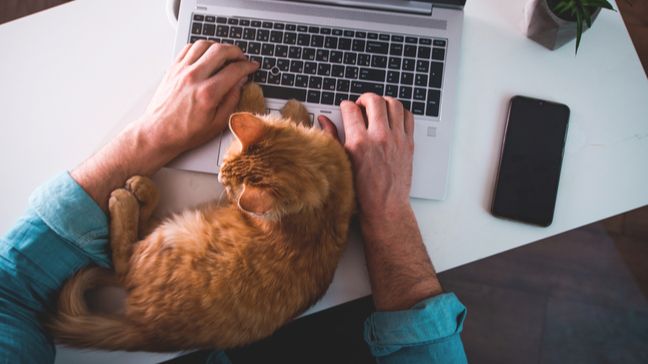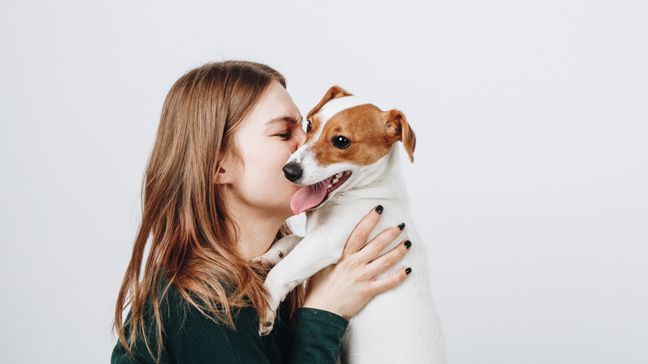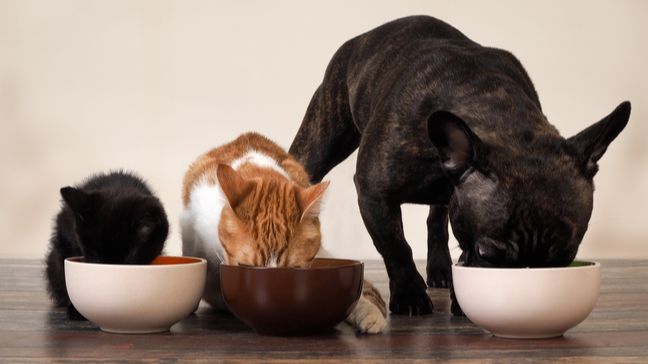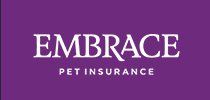Over half of American households have a pet. But among Millennials specifically, that number is over 70%, according to the Wall Street Journal. We love our pets so much that we’d sooner give up sugar, alcohol, and social media than our four-legged best friends.
As we continue to empty animal shelters at record rates, one can’t help but wonder a few things, like:
- Why do Millennials love their pets so much?
- Are we taking better care of our pets than previous generations?
- How can you take the best care of your pet at a discount?
Let’s investigate Millennials and their pets!
Why do Millennials love their pets so much?

As I write this, my 35-lb mutt Joy is curled at my feet. I know she’s hoping to hear one of the magic four-letter words (Park? Play? Walk?), but if she doesn’t, she still loves me unconditionally (and vice versa).
I adopted Joy Butsch a few years back for the same reason most Millennials get their pets; they provide an affordable and consistent source of companionship.
Compared to our parents’ generation, Millennials are significantly less likely to be married or cohabitating by age 40. And while I think it’s good that we’re taking our time to develop our careers and discover what we truly want out of life, in the meantime, it’s nice to come home to someone who loves you (regardless of species).
Even Millennials already in long-term, healthy relationships are big-time pet lovers. Millennials who are married or cohabiting are more likely than their parents to adopt a pet before having children.
The reasons why Millennials choose pets over kids are as copious as they are obvious.
Pets are cheaper than kids
First, animals are orders of magnitude more affordable than children. The cost of owning a cat for 18 years can be as little as $9,000, and dogs are even cheaper. By contrast, the cost of raising a single child through age 18, including costs associated with birth, is well in the hundreds of thousands of dollars range.
Having a pet is easier than raising a child
Furthermore, pets are just easier than kids. Many Millennials are concerned about the impact having children will have on their mental health, and rightfully so. Pets, by contrast, are well-proven to support emotional well-being and reduce rates of mental illness.
You can have pets and still have your freedom
Millennials also prefer pets to children because you can more easily have a pet and a full-time job. Many Millennials are unsure if they ever want to start a family, since doing so often leads to significant sacrifices and loss of freedom.
I can’t think of anyone, however, who’s had to choose between their cat and their career.
Pets offer a “test run” before having children
Finally, many Millennials who are considering becoming parents will still adopt pets as a “dry run” for parenthood. Raising a kitten or a puppy is no cakewalk, with endless accidents, sleepless nights, and other unpleasant surprises. Knowing this, many Millennial couples will adopt a pet together to stress-test the relationship (and avoid a costly mistake).
So, Millennials are adopting pets in record numbers for all the right reasons. The next important question is, are we taking good care of them?
Are Millennials taking better care of their pets than previous generations?

Yes. As above, plenty of factors are at play here.
With fewer children, Millennials can invest more time in our pets. Two-thirds of us see our pets as “part of the family,” and an equal number would take a sick day from work just to take care of our furry friend, according to TD Ameritrade.
We can invest more money, too. Despite having one-tenth the wealth of our parents, Millennials spend more than any other generation on our pets, according to Business Insider. We’re more likely than older generations to purchase organic food for our pets, and are the most likely generation to host a pet birthday party.
How have Millennials impacted the pet care industry?

In 1996, Americans spent $21 billion on their pets. Thanks to Millennials, that number will soon reach $100 billion, according to the American Pet Products Association.
Spending has increased across the board, with Millennials investing record amounts in food and treats ($37 billion), medications ($29 billion), and vet care ($19 billion).
Our massive investment in pet care as a generation has fundamentally changed the face of the industry. Between 1991 and 2015, vet care spending alone increased by a factor of seven, leading to increased R&D and entirely new treatments. In the 90s, you couldn’t treat your dog for depression or schedule your cat for underwater therapy to help her arthritis; now, you can.
With adoption rates skyrocketing, increased food spending naturally followed. But Millennials didn’t just demand more food; they demanded better food for their pet. According to a report by Pet Food Industry, Millennials are the “most picky” and “seek and demand sustainably sourced products, natural and holistic pet foods and full transparency – and all at a low price.”
Such demands from the most pet-owning generation have forced pet food production giants like Nestle to produce more ethically-sourced, higher quality pet food at an affordable price; a trend all generations can benefit from.
For many Millennials, lugging a 25-pound bag of chow home from Publix is neither convenient nor, for some, even physically possible. Therefore, Millennials’ demand for convenient pet supply delivery has given rise to companies like Chewy, Nom Nom, and more.
All in all, Millennials’ massive spending on their pets has increased the quality, convenience, and affordability of care for all pets of all generations. Go us!
That being said, let’s bring this high-level discussion of trends and billions back down to earth. What are some concrete, cost-effective ways you can spend a little more on your pet?
How can you take better care of your pet?

Taking better care of your pet is an investment; it may cost a little more in the short term, but it’ll pay off in big ways when you have a happier, healthier pet.
Purchase insurance
I’m willing to bet that lots of folks don’t even know that pet insurance exists.
In September of 2020, fewer than 2% of America’s pets were covered by insurance. However, a third of pet owners will financially benefit from pet insurance since one in three pets will make a trip to the emergency room this year.
If you’re considering getting your pet covered, which companies offer the best deals?
Lemonade
 Lemonade may be the most admirable and disruptive company in the insurance space. Lemonade Pet Insurance includes a very long list of covered procedures, including bloodwork, labwork, emergency care, surgeries, CT scans, ultrasounds, and medications. And if you opt for the wellness package, it includes coverage for heartworm testing, fecal testing, annual wellness visits, and more!
Lemonade may be the most admirable and disruptive company in the insurance space. Lemonade Pet Insurance includes a very long list of covered procedures, including bloodwork, labwork, emergency care, surgeries, CT scans, ultrasounds, and medications. And if you opt for the wellness package, it includes coverage for heartworm testing, fecal testing, annual wellness visits, and more!
Lemonade wants to make sure your cat or dog gets the right coverage they need. This is why they offer expert online medical advice, on top of all of their covered services, through online chat. That way you don’t have to constantly pester your vet with small questions.
And the best part? Premiums are as low as $10 per month.
Learn more about Lemonade today.
Embrace
 Embrace is all about breadth and variety. They have policies with a wide range of limits and plenty of sliders to play with in their quote wizard so you can find a combination of terms that works best for you.
Embrace is all about breadth and variety. They have policies with a wide range of limits and plenty of sliders to play with in their quote wizard so you can find a combination of terms that works best for you.
Plus, one of Embrace’s key competitive advantages is that they’ll cover breed-specific conditions. In addition, Embrace will cover genetic, preventable, and even behavioral conditions. Best of all, they have a surprisingly brief waiting period of just two days for accidents and 14 days for illness (the industry median is about 30).
Learn more about Embrace Pet Insurance today.
Pumpkin
 Pumpkin offers a few annual limit options ($10,000 or $20,000 for dogs, $7,000 or $15,000 for cats) and a 90% reimbursement rate. Pumpkin also offers an optional preventative care pack, separate from insurance, that reimburses 100% of some key things that vets recommend. This includes an annual wellness visit, vaccines, and key diagnostic tests.
Pumpkin offers a few annual limit options ($10,000 or $20,000 for dogs, $7,000 or $15,000 for cats) and a 90% reimbursement rate. Pumpkin also offers an optional preventative care pack, separate from insurance, that reimburses 100% of some key things that vets recommend. This includes an annual wellness visit, vaccines, and key diagnostic tests.
If you like the idea of getting your pet insurance for when things go wrong, and also preventative care to keep them healthy year-round, you should definitely check out Pumpkin.
Learn more about Pumpkin today.
Pumpkin Advertiser Disclosure: Pumpkin Pet Insurance policies do not cover pre-existing conditions. Waiting periods, annual deductible, co-insurance, benefit limits and exclusions may apply. For full terms, visit pumpkin.care/insurancepolicy. Products, discounts, and rates may vary and are subject to change. Pumpkin Insurance Services Inc. (“Pumpkin”) (NPN #19084749) is a licensed insurance agency, not an insurer. Insurance is underwritten by United States Fire Insurance Company (NAIC #21113, Morristown, NJ), a Crum & Forster Company and produced by Pumpkin. Pumpkin Preventive Essentials is not an insurance policy. It is offered as an optional add-on non-insurance benefit. Pumpkin is responsible for the product and administration. Pumpkin Preventive Essentials is not available in all states. For full terms, visit pumpkin.care/customeragreement.
Give your pet plenty of toys and playtime
Remember how bored we were before smartphones? That might be how your pet feels without a few toys lying around!
For cat owners, PetMD recommends a one-time investment in a good cat tree, which can offer your cat a climbing gym, a scratching post, and a vantage point to intimidate the neighborhood rodents. They also recommend two to four 10-minute play sessions per day to keep your cat healthy and stimulated.
Dogs, according to the American Kennel Club, can be perfectly happy lounging around for six-eight hours per day. But to balance that, they like to have at least two hours of human contact time, whether that’s playing in the park or simply curling up at your feet as you work. As for one-on-one walk or playtime, says Dogster, 30 minutes is a minimum, but your dog will love you even more if you can make it an hour.
If you have another species at home, ask Dr. Google what kinds of toys, treats, and quality time they like!
Invest in better quality food
Fun fact: to be certified organic, pet food must meet the same USDA standards as human organic food. That said, is it worth the extra cash for the organic, certified, “complete” brands?
Well, the overall best food for your pet is simply the kind that your veterinarian recommends. Before your next visit, take a picture of the food brand you’re currently feeding your pet. Be sure to get the nutrition facts and list of ingredients, too. Then, show it to your vet for suggestions or alternatives.
As with all living species, a healthier diet pays off every day!
Invest in preventative care for common conditions
Preventative care is always cheaper than acute care. A single dose of heartworm medication can cost less than $5, but heartworm treatment can cost hundreds.
It may not be fun, but it pays off to know what conditions your pet is vulnerable to, and how to prevent them. Perform a few Google searches, like:
- “[Your pet’s species/breed] common conditions.”
- “[Your pet’s species/breed] preventative care.”
- “[Your pet’s species/breed] recommended supplements.”
This will give you an idea of how you can spend $5 to $25 a month on preventative care for your pet, saving thousands in the long run on expensive treatments.
Find the right vet
Wanting to save money on veterinary costs doesn’t make you a bad pet parent; it’s just good business. Keep in mind that many low-end outpatient procedures are just commodities; you’ll get the same basic check-up or tick treatment whether you pay $150 or $350.
If you live in a major city, consider driving out to the ‘burbs or even to rural areas where quality vet care is often much more affordable. I drive 30 minutes to my vet, who does an amazing job for less than half the price of vets inside Atlanta.
If you do drive a little further for vet care, however, be sure that you know where the nearest 24/7 pet hospital is in case of an emergency.
Summary
Pets are a superb investment. They provide virtually everything we need to get through the challenges of our generation: companionship, emotional support, exercise, laughter, baby practice, and more.
As a pet parent, increasing your time and money investment by just 20% will pay off in big ways. You can see a more affordable vet more frequently, invest in some healthier food and treats, and simply spend more time frolicking with your pet in the yard.
My hope is that your days with your furry long one are long (and cost-effective).